Widgetized Section
Go to Admin » Appearance » Widgets » and move Gabfire Widget: Social into that MastheadOverlay zone
The Super Sig
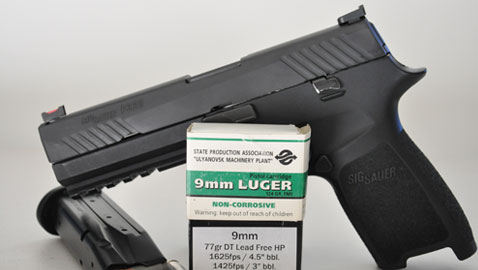 That’s what Michael Bane calls it, the Super Sig, a 9mm Sig P320 worked over by Bruce Gray and the folks at Grayguns. What’s a Super Sig? Well, not long after Sig brought us the new P320 pistol I got my mitts on one, liked it enough to buy it, wrote it up for DRTV and have been shooting and carrying it ever since. But early on I became aware of a (at that time) secret project going on between Sig and Grayguns. It was secret because they were plotting and scheming to field a competitive shooting team with Gray as the leader and the shooters would be equipped with specially modified P320s, or Super Sigs. A bit after the secret started to slip out Gray showed me an example and after testing the trigger I was hooked. I promptly sent my pistol off for modification and waited impatiently for it to return.
That’s what Michael Bane calls it, the Super Sig, a 9mm Sig P320 worked over by Bruce Gray and the folks at Grayguns. What’s a Super Sig? Well, not long after Sig brought us the new P320 pistol I got my mitts on one, liked it enough to buy it, wrote it up for DRTV and have been shooting and carrying it ever since. But early on I became aware of a (at that time) secret project going on between Sig and Grayguns. It was secret because they were plotting and scheming to field a competitive shooting team with Gray as the leader and the shooters would be equipped with specially modified P320s, or Super Sigs. A bit after the secret started to slip out Gray showed me an example and after testing the trigger I was hooked. I promptly sent my pistol off for modification and waited impatiently for it to return.
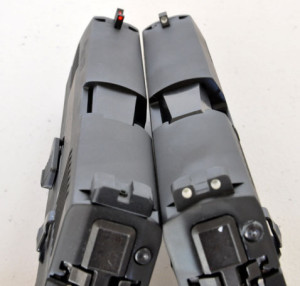 What I got back was a pistol that looks completely stock except for the sights. But the trigger is now the best striker fired trigger I have experienced. The trigger wasn’t bad to begin with – it had a bit of take-up and broke at around 7 pounds. It was a good, usable trigger with a smooth face and no safety-thingy lever. Gray states he can get a 4-pound trigger on these pistols and that is exactly what he delivered. Okay, full disclosure here; I find it difficult to measure striker fired pistol triggers with my Lyman electronic trigger gizmo. It’s, essentially, a strain gauge and will give different readings depending upon what portion of the trigger it contacts. For single action triggers like a 1911 it’s easy to get consistent readings by placing the arm of the gauge in the center of the trigger. I’ve found the best consistency with striker fired triggers occurs when I place it on the lower third of a trigger, and using that method I arrived at a 4 pound, and maybe an ounce or two, average trigger reading for the Super Sig. Grayguns call this level of trigger work Competition Action Cleanup Perfection, which is another way of saying they go through the entire action chassis of the pistol and cleanup, adjust and polish the parts. It’s way more than a “trigger job”.
What I got back was a pistol that looks completely stock except for the sights. But the trigger is now the best striker fired trigger I have experienced. The trigger wasn’t bad to begin with – it had a bit of take-up and broke at around 7 pounds. It was a good, usable trigger with a smooth face and no safety-thingy lever. Gray states he can get a 4-pound trigger on these pistols and that is exactly what he delivered. Okay, full disclosure here; I find it difficult to measure striker fired pistol triggers with my Lyman electronic trigger gizmo. It’s, essentially, a strain gauge and will give different readings depending upon what portion of the trigger it contacts. For single action triggers like a 1911 it’s easy to get consistent readings by placing the arm of the gauge in the center of the trigger. I’ve found the best consistency with striker fired triggers occurs when I place it on the lower third of a trigger, and using that method I arrived at a 4 pound, and maybe an ounce or two, average trigger reading for the Super Sig. Grayguns call this level of trigger work Competition Action Cleanup Perfection, which is another way of saying they go through the entire action chassis of the pistol and cleanup, adjust and polish the parts. It’s way more than a “trigger job”.
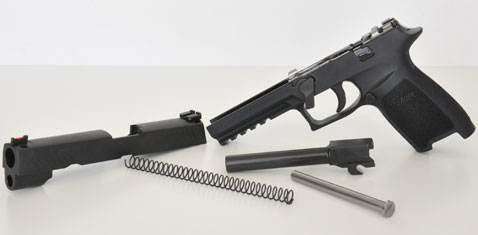 Taking the Super Sig apart, I discovered the next modification. Instead of the stock captive Sig recoil spring Gray installs a non-captive spring on a heavy, one-piece guide rod. The spring is a 15 pound 1911 recoil spring and you might wonder why that’s an improvement over the one-piece Sig unit some German engineer doubtlessly designed to perfection. Good question. As far as I can tell it doesn’t improve functioning, as the pistol has always functioned perfectly with every brand of ammunition I’ve been able to scrounge up and shoot through it. With the 15 pound spring the slide is slightly easier to pull back compared to the stock spring but I don’t think that’s what its for. I think the idea is that 1911 mainsprings are much more widely available and they can be found in various weights from very light to very heavy, allowing the Super Sig shooter to tune the pistol for various loads. As to the heavy guide rod, shooters, and in particular
Taking the Super Sig apart, I discovered the next modification. Instead of the stock captive Sig recoil spring Gray installs a non-captive spring on a heavy, one-piece guide rod. The spring is a 15 pound 1911 recoil spring and you might wonder why that’s an improvement over the one-piece Sig unit some German engineer doubtlessly designed to perfection. Good question. As far as I can tell it doesn’t improve functioning, as the pistol has always functioned perfectly with every brand of ammunition I’ve been able to scrounge up and shoot through it. With the 15 pound spring the slide is slightly easier to pull back compared to the stock spring but I don’t think that’s what its for. I think the idea is that 1911 mainsprings are much more widely available and they can be found in various weights from very light to very heavy, allowing the Super Sig shooter to tune the pistol for various loads. As to the heavy guide rod, shooters, and in particular 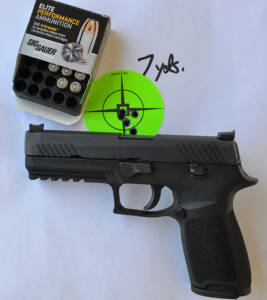 competitive shooters, tend to believe they shoot better and can fire rapid controlled shots better if there is more weight on the front of the gun and heavy guide rods are one way to accomplish this. I weighed the 1911 spring and guide rod and compared it to the captive spring Sig unit and the “heavy” version comes in at one-half an ounce heavier. Will that really make a difference in your shooting? I can’t say, as I can’t detect a difference, but if you think it will make you shoot better it will.
competitive shooters, tend to believe they shoot better and can fire rapid controlled shots better if there is more weight on the front of the gun and heavy guide rods are one way to accomplish this. I weighed the 1911 spring and guide rod and compared it to the captive spring Sig unit and the “heavy” version comes in at one-half an ounce heavier. Will that really make a difference in your shooting? I can’t say, as I can’t detect a difference, but if you think it will make you shoot better it will.
The P320 comes with an excellent set of three dot Siglite night sights but, with competition in mind, Gray replaces them with a Dawson Precision front sight consisting of a red fiber optic front sight set in a square base and a custom, plain black rear sight designed by Scott Conti at SPD Tool. The night sights aren’t necessary for a competitive shooter but wait, you might ask, why would you want to give them up for a defensive pistol? My answer to that is, as nice as night sights are under certain lighting conditions, I would rather dispense with the dots, use a plain black rear sight and have a front sight that really grabs my attention. The Dawson/Conti sights feature a wide notch on the rear sight and a narrow post for the front that allow me to center that red dot quickly. I’ve been shooting this pistol through a number of range drills and used it for two days while filming a Shooting Gallery TV segment that had me being put through a number of complex scenarios and, I have to tell you, it works. The pistol runs flawlessly, it’s more accurate than I need, and the sights and trigger help me hit quickly.
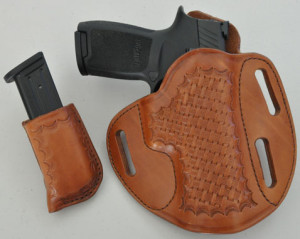 Lastly, I mentioned I’m carrying the Super Sig a lot lately. I had Simply Rugged Holsters make me a nice basketweve carry rig and I’m doing something a little off-the-wall with ammo selection. I’ve been really impressed with DoubleTap’s 77 grain, 1400 feet per second 9mm hollowpoint load that expands and penetrates far better than you might imagine for such a lightweight bullet. Along with it, I’m loading every other round in the magazine with some Russian full metal jacket I stumbled upon several years ago that penetrates sheet metal and standard body armor quite well (Bad Guys wear armor, you know). With the mix of ammo I feel like I’ve got most problems covered. As darkness falls, I attach a Streamlight TLR-2 HL G weapon light to the Picatinny rail of the P320SS that features a blinding 700 plus lumen light and a green laser.
Lastly, I mentioned I’m carrying the Super Sig a lot lately. I had Simply Rugged Holsters make me a nice basketweve carry rig and I’m doing something a little off-the-wall with ammo selection. I’ve been really impressed with DoubleTap’s 77 grain, 1400 feet per second 9mm hollowpoint load that expands and penetrates far better than you might imagine for such a lightweight bullet. Along with it, I’m loading every other round in the magazine with some Russian full metal jacket I stumbled upon several years ago that penetrates sheet metal and standard body armor quite well (Bad Guys wear armor, you know). With the mix of ammo I feel like I’ve got most problems covered. As darkness falls, I attach a Streamlight TLR-2 HL G weapon light to the Picatinny rail of the P320SS that features a blinding 700 plus lumen light and a green laser.
Is the Super Sig a competition pistol or an optimized defensive pistol? You’ll have to decide for yourself – I’ve made up my mind.
For more information:
www.grayguns.com
www.sigsauer.com
www.simplyrugged.com
www.streamlight.com
www.doubletapammo.net
About the Author:
 Ed Head is a regular on Shooting Gallery, Gun Stories and Down Range TV. He has worked for almost 30 years in law enforcement, first in the United States Air Force and then with the United States Border Patrol, retiring as a Field Operations Supervisor. During his Border Patrol career, Ed worked in a variety of patrol, investigative and training capacities. Ed has an extensive background as a firearms instructor, having trained thousands, ranging from beginners to police, military and special operations personnel. Having taught at Gunsite for 20 years, Ed first trained there under the world famous shooting school’s founder, Jeff Cooper, then later ran the school as the operations manager for more than five years. Ed lives in Chino Valley, Arizona, where he continues to teach and write.
Ed Head is a regular on Shooting Gallery, Gun Stories and Down Range TV. He has worked for almost 30 years in law enforcement, first in the United States Air Force and then with the United States Border Patrol, retiring as a Field Operations Supervisor. During his Border Patrol career, Ed worked in a variety of patrol, investigative and training capacities. Ed has an extensive background as a firearms instructor, having trained thousands, ranging from beginners to police, military and special operations personnel. Having taught at Gunsite for 20 years, Ed first trained there under the world famous shooting school’s founder, Jeff Cooper, then later ran the school as the operations manager for more than five years. Ed lives in Chino Valley, Arizona, where he continues to teach and write.



 MidwayUSA
MidwayUSA Ruger Firearms
Ruger Firearms SCCY Firearms
SCCY Firearms Streamlight
Streamlight Action Targets
Action Targets Gunsite Academy
Gunsite Academy
You must be logged in to post a comment Login